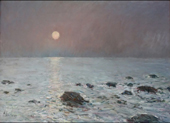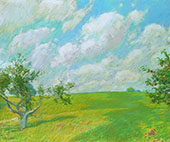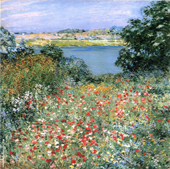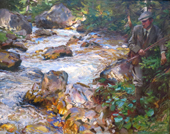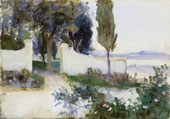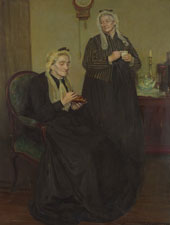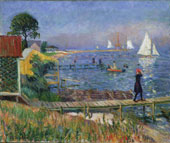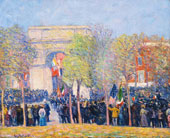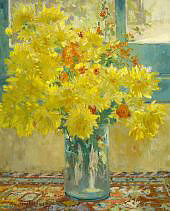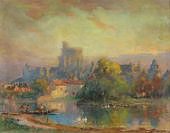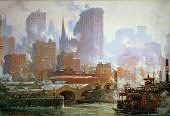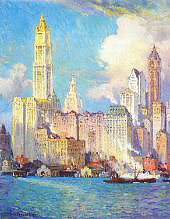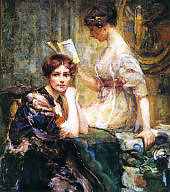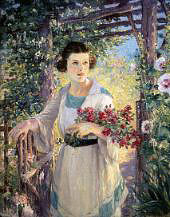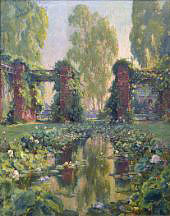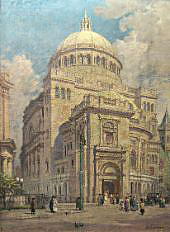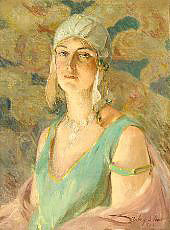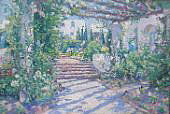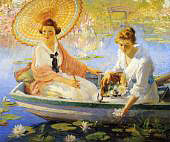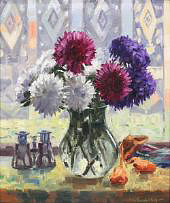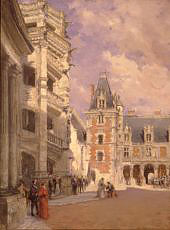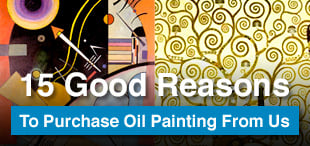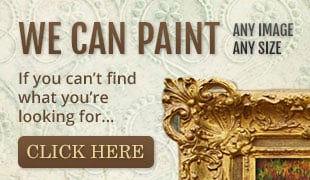American Impressionism Oil Painting Reproductions
Find American Impressionism oil painting replicas by American Impressionism artists
American Impressionism: A Brief Introduction
American impressionism heralded a new era of unparalleled beauty and creativity in American Art. This art movement prevailed from the 1880s to the early 20th century, providing a unique artistic style and fascinating insights into American and European society.
This brief introduction explores the art movement’s defining characteristics, its leading artists, and their most famous impressionist paintings.
How did American Impressionism begin?
While trying to understand the rise of American Impressionism, it is essential to reference the movement within the rising global wealth and significance of the USA. At the end of the Civil War in 1865, the American economy rapidly expanded, resulting in affluent art patrons, often from the victorious Northern states. They often traveled to Europe, purchasing paintings by the Old Masters and modern artists, emulating their work in the style of Classical Art. Consequently, many American artists started traveling to develop their artistic training in Europe. Paris was the epicenter of artistic creativity, and it was here that American Impressionist artists found inspiration.
Soon after American interest in European art took off, the French Impressionists launched their opening exhibition in Paris. The first Impressionist Exhibition occurred in 1874 and was held eight times until 1886. The Impressionists rejected the classical approaches favored by many European academies and American collectors. Instead of meticulous classic Greek mythology paintings, Impressionist paintings feature scenes of everyday life. Using dappled, light brushwork and vibrant coloring, Impressionists painted the new “modernity.” Americans studying in Paris during the 1870s ignored the new Impressionist movement. Instead, many studied at the prestigious Académie Julien under teachers such as Jean-Leon Gerome. Indeed, the few American artists who noticed famous impressionist paintings were horrified. American impressionist artist J. Alden Weir said he has never seen “more horrible things.”
Who started American Impressionism Art?
In terms of the initial pioneers of American Impressionism artists, Mary Cassatt was an early leading figure of the American Impressionist art movement. She moved to Paris in 1874 from her native Pennsylvania and quickly adopted the new French Impressionist style. Cassatt became close friends with Edgar Degas, who invited her to show alongside the group. The pair had such a close working relationship that he advised Mary Cassatt on her oil paintings and sometimes even painted on her canvases. Cassatt wrote about her famous oil painting Little Girl in a Blue Armchair that Degas “found it good.” He “advised her on the background” and worked on the composition. Art Historians believe Degas painted the floor between Cassatt’s armchairs. He also possibly painted the light streaming through the windows.
John Singer Sargent, born to expatriate American parents, also studied in Paris around the same time. He met Claude Monet, the father of Impressionism, in the mid-1870s and deeply admired his work. Indeed, Monet inspired Singer Sargent to create some of his liveliest oil paintings full of color and movement. Singer Sargent's paintings include Claude Monet's Painting The Edge of The Woods and Carnation Lily, Lily Rose, and his most famous Flaming June painting. Painted in 1895, Flaming June is one of our most popular paintings, and John Singer Sargent is one of our most popular artists.
What are the five characteristics of Impressionism?
The American Impressionists and their European counterparts shared incredibly close links. With this in mind, exploring the critical characteristics of French Impressionism in more detail is worthwhile. While this covers a massive array of painters and styles, five main features include:
- Quick, loose, and visible brushwork
- Bright, vivid, unblended coloring
- Painting “en plein air” (outside) or “in situ” (in homes, bars, or restaurants)
- Emphasizing exact depictions of natural light
- Reflecting on fleeting moments and everyday life
Unlike classical approaches, Impressionist artists favored cropped compositions, playful perspectives, and off-center compositions. In addition, they painted modern life rather than classical myths and religious subjects, using paints straight from the tubes. The result is a technique that creates a thick, impasto painting style with rapid, energetic strokes. Just like French Impressionism, American Impressionist paintings often featured landscapes and seascapes. Nonetheless, they also focus heavily on domestic and urban scenes.
What is American Impressionist painting?
American Impressionist artists emulate the style and technique of the French Impressionist movement, depicting modern life with intense light, color, and energy. They ignored classical and academic approaches. Instead, they present their impressions of contemporary life and the ever-changing effects of light. While French artists focused on more traditional landscapes, American Impressionists frequently depicted urban and domestic scenes and country landscapes. Oil paintings by Mary Cassatt and Frank Weston Benson primarily focus on domestic and homely scenes that include women and children. For instance, Eleanor by Frank Weston Benson portrays his daughter. Similarly, Mary Cassatt often provides intimate glimpses of domestic scenes with oil paintings such as Woman Bathing, painted in 1891.
Conversely, oil paintings by Childe Hassam of the streets of Paris and New York depict urban modernity in all its glory. Painted in 1917, famous flag paintings, such as The Avenue in the Rain by Childe Hassam, are a masterpiece of American Impressionism. The painting is also a moving tribute to American sacrifices in the First World War. Painted just after America entered the conflict, it uses quick dappled brushstrokes to show the unbridled optimism of contemporary American society. Notwithstanding this fame, Hassam’s beautiful seascapes, such as Duck Island from Appledore, also earned him the “American Monet” title.
The American Impressionists' deep interest in France appears in oil paintings by William Glackens. His painting Chez Mouquin of 1905 provides a fascinating glimpse into 20th century French fashion and its growing impact on American culture.
Who are the leading American Impressionists?
Leading American Impressionist artists include Mary Cassatt, John Singer Sargent, Childe Hassam, William Glackens, and Frank Weston Benson. In addition, William Merritt Chase was the first American painter to produce Impressionist works in the United States. He created a beautiful series depicting New York’s public parks. This series of landscape paintings launched Merritt Chase’s name in the American art world. His success also inspired other artists to visit European artists’ colonies. Monet's gardens at Giverny were especially popular, with artists bringing Monet’s revolutionary ideas back to the United States. Chief among these ideas was a focus on painting outdoors, en plein air painting, to capture the fleeting beauty of the natural world. With sun-soaked canvasses such as The Seaside, William Merritt Chase exemplifies a light and airy feeling in his paintings.
From the 1890s onwards, Impressionism was no longer an import but a respected genre of American art. As a result, many painters, such as William Merritt Chase and Henry Twachtman, launched summer schools teaching this exciting new painting style. Indeed, Chase taught each summer on the east end of Long Island until 1902. Henry Twachtman shared his artistic knowledge from the artists' colony at Cos Cob, Connecticut. The French painterly connections are immediately apparent in The White Bridge, inspired by Claude Monet'sJapanese Bridge paintings.
Why is American Impressionism Art important?
American Impressionism was essential for bringing avant-garde artistic ideas to American shores. These trailblazing artists established art colonies and groups throughout the United States, forming the foundation for later American creativity. As a result, new art movements such as Abstract Expressionism art, Action Painting, and Color Field Paintings were allowed to emerge. As well as their dazzlingly beautiful and dynamic creations, they supplied a new sense of national pride in American arts and culture. Furthermore, American Impressionist art displays cross-cultural communication's positive and imaginative potential. American Impressionism faded in the 1910s and 1920s, replaced by the overt realism of artists from the Ashcan School and the Impressionist oil painting, with their bright colors and pretty scenes viewed as outdated.
Further adding to this stylistic shift, in 1913, New York City launched an exhibition titled the “Armory Show.” The Exhibition displayed the latest European Fauvism and Cubism painting trends, making the American Impressionists’ everyday subjects feel more out of touch.
American Impressionist Fine Art Reproductions
If you love the energy and beauty of American Impressionist oil painting, please explore our extensive collection of oil painting reproductions from famous American Impressionist artists. You can also discover fine art reproductions of famous American oil paintings.
Cannot Find What You Are Looking For?
Reproduction Gallery Information
Customer Service
(Send Us A Message)
Tel: (503) 937 2010
Fax: (503) 937 2011









